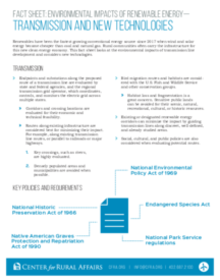Policy
Renewables have been the fastest growing conventional energy source since 2017 when wind and solar energy became cheaper than coal and natural gas. Rural communities often carry the infrastructure for this new clean energy economy. This fact sheet looks at the environmental impacts of transmission line development and considers new technologies.
Transmission
- Endpoints and substations along the proposed route of a transmission line are evaluated by state and federal agencies, and the regional transmission grid operator, which coordinates, controls, and monitors the electric grid across multiple states.
- Corridors and crossing locations are evaluated for their economic and technical feasibility.
- Routes along existing infrastructure are considered best for minimizing their impact. For example, along existing transmission line routes, or parallel to railroads or major highways.
- Key crossings, such as rivers, are highly evaluated.
- Densely populated areas and municipalities are avoided when possible.
- Bird migration routes and habitats are considered with the U.S. Fish and Wildlife Service and other conservation groups.
- Habitat loss and fragmentation is a great concern. Sensitive public lands can be avoided for their scenic, natural, recreational, cultural, or historic resources.
- Existing or designated renewable energy corridors can minimize the impact by guiding transmission lines along discreet, well-defined, and already studied areas.
- Social, cultural, and public policies are also considered when evaluating potential routes.
Best practices
New technologies and energy alternatives can reduce the demand for new generation and infrastructure for renewables. These include:
Energy efficiency: Efficiency should be the first component of new energy developments. Focusing on energy efficiency can boost reliability and resiliency in times of stress.
Microgrids: Investing in small grids along with energy storage and efficiency can reduce peak demand while boosting reliability.
Energy storage: Storing power generated on-site can help reduce peak demand for electricity and reduce costs for consumers.
Demand response: Each of these best practices, along with smart transmission line development, can create a more adept demand response making electricity more reliable and affordable.


